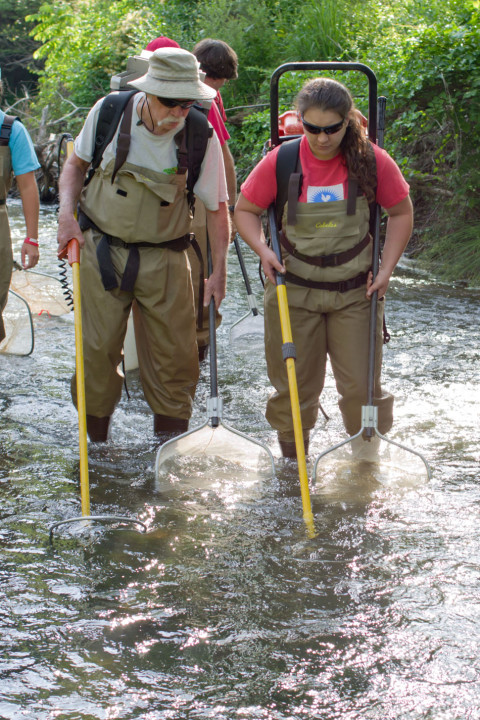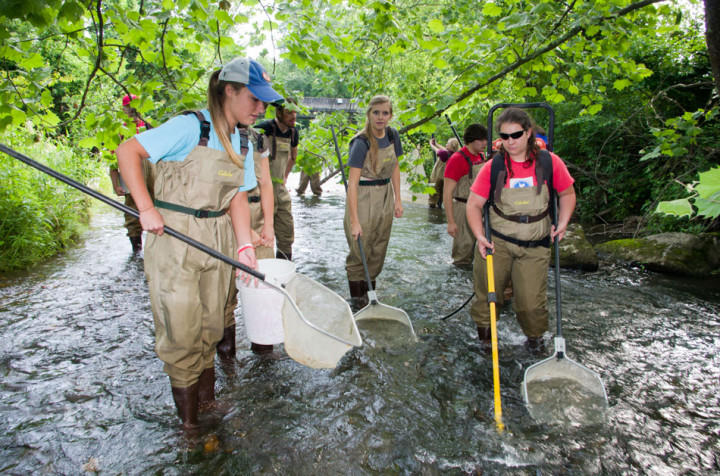Standing knee-deep in the Little Tennessee River, Haley Williams wears a broad smile as she and her classmates fill a bucket with temporarily stunned fish. “We’ve been waiting for this all year,” says Williams, sporting hip waders and a camouflage T-shirt. Amid the verdant north Georgia mountains, she and about two dozen other Franklin High School biology students are taking part in an annual field trip led by the Land Trust for the Little Tennessee.
Wielding portable generators, Bill McLarney and another land trust staffer repeatedly run a current through this shimmering stretch of water, giving students a window into the river’s biodiversity. Each summer, the Franklin, N.C.-based nonprofit conducts biological monitoring in some 30 waterways, from the headwaters in north Georgia to Fontana Reservoir in North Carolina, compiling an index of ecosystem health.

Western North Carolina has relatively healthy waterways, thanks in part to the region’s large amount of public land, says McLarney, the land trust’s senior scientist. But the data gleaned from stream monitoring help state and local governments shape land-use and development policies that can have a crucial impact on watershed health. Water quality advocates, meanwhile, use the information to bolster their push for environmentally friendly policies and to obtain grants for specific conservation and restoration projects. The data also help regulators identify pollution sources.
Healthy waterways, notes McLarney, are “fundamentally related to our own health,” whether they’re used for drinking water or recreation.
But elected officials charged with shaping environmental policy often lack the kind of technical background that could help them deconstruct these complex issues. And meanwhile, severe budget cuts are increasingly limiting state agencies’ ability to protect water quality.
Against that backdrop, the work of nonprofits like the land trust looms very large indeed, says David Gillette, assistant professor of environmental science at UNC Asheville. And as the state continues shrinking its environmental staff, he continues, water quality problems “are going to have to be solved by the grassroots.”
Grassroots action
The most serious threats to the region’s rivers and streams are sedimentation and stormwater runoff. Sedimentation, caused partly by erosion from farmland and construction sites, can smother oxygen-producing plants, increase water temperature and kill fish. Runoff may also contain fertilizers, pesticides, automotive chemicals and other pollutants.
Such contaminants have long affected Hendersonville’s Mud Creek. The state classifies parts of it as impaired, meaning they fail to meet state water quality standards. The creek, which drains nearly 115 acres, is a tributary of the French Broad River, parts of which are also listed as impaired.
“Until we can figure out a way to keep rainwater from washing off the streets … we’re going to have a problem,” says Mary Jo Padgett, co-founder of the Hendersonville-based Environmental & Conservation Organization.
ECO was formed in the late 1980s, when Henderson County was seeing rapid population growth. The county commissioners were considering whether to build a new landfill or a solid waste incinerator, and meanwhile, a local business wanted to site an asphalt plant on wetlands, Padgett says. Despite the complex environmental issues involved, however, “Nobody seemed to have much expertise.”
Since then, she says, the group has tackled topics ranging from land-use management to transportation planning to renewable energy. The nonprofit also monitors more than two dozen waterways in the region and organizes volunteer river cleanups, relying on “an army of volunteers,” notes Padgett.
Mills River residents Jim and Sharon Spicer, for example, have been working with ECO for a dozen years, coordinating samplings of nearly three dozen Henderson County waterways “every month — rain or shine, snow or ice,” he reports. But the state cutbacks have made it “harder now to get things done,” because while volunteer groups can report violations, they lack the authority to enforce the law, Spicer says.
ECO and the Land Trust for the Little Tennessee are just two of many local groups monitoring the health of Western North Carolina’s rivers, streams and creeks — watersheds, she says, that are extraordinarily rich in biodiversity.
State environmental staff slashed
Back in February, a massive spill dumped 39,000 tons of coal ash into the Dan River, north of Greensboro. Nonetheless, the following month, the Department of Environment and Natural Resources cut 68 staff positions in the Division of Water Resources as part of a departmental reorganization mandated in 2011. Besides classifying waterways, the Division of Water Resources tests dozens of them each month for things like pH level and bacteria, though the agency covers far fewer sites than the various nonprofit groups.
The award-winning Ecosystem Enhancement Program, hailed as a national model for dealing with stream and wetlands restoration, lost nearly one-third of its staff.
And last year, DENR returned nearly $600,000 in U.S. Environmental Protection Agency grants awarded to the Program Development Unit, which was eliminated as part of the reorganization. According to a Sept. 13, 2013, editorial in The News & Observer of Raleigh, more than one-third of the money would have paid for monitoring streams and wetlands in central North Carolina that could be affected by hydraulic fracturing, or fracking, that may be done in the future; the remainder would have funded other work pertaining to surface water protection.
State lawmakers maintain that the reductions will increase governmental efficiency without jeopardizing environmental or public health. The editorial, however, said: “Eliminating the unit and rejecting the grants raises a question of whether DENR’s so-called efficiencies are simply a reduction in the quality and breadth of environmental regulation. So far, there’s $582,305 headed back to the EPA that says that’s just what it is.”
The General Assembly has also continued to cut funding for entities such as the Clean Water Management Trust Fund, which, since its establishment in 1996, has distributed more than $200 million in grants to environmental groups in the mountain region. In Buncombe County alone, the fund has helped finance some 30 major projects, including stream restorations and land acquisitions by conservation groups.
Yet in the current two-year budget cycle, the General Assembly has allocated about $7 million annually for the fund — the smallest amount since it was established in the mid-1990s to protect watersheds in the wake of a huge fish kill in the Neuse River, in the eastern part of the state.

Rivers and the economy
Environmental advocates also voice concern about the cutbacks’ potential economic impacts.
“The health of our economy depends on our environment,” says Karen Cragnolin, who’s served on the trust fund’s board since its inception. Adventure tourism, farm-to-table restaurants and organic gardens, she points out, all require clean water. “Our whole image is based on this sustainability.”
That’s proved particularly true for Asheville, with numerous outfitters now running the French Broad and two major craft brewers, New Belgium and Sierra Nevada, building production facilities in the watershed. Both companies based their decisions, in part, on the area’s reputation for abundant water resources and outdoor recreation, says Cragnolin, who is executive director of the Asheville-based nonprofit RiverLink. Sierra Nevada is using two wells on its Mills River property for brewing, notes spokesperson Bill Manley.
But the river wasn’t always considered such an asset: In the 1950s and ’60s, industrial discharges were largely unregulated. “It was a disaster,” says Cragnolin.
Local author Wilma Dykeman’s 1955 book The French Broad spotlighted the river’s problems and potential, but even after the passage of the federal Clean Water Act in 1972, progress was slow. Commercial rafting began on the river in the mid-’70s, and by the early ’80s, several companies had outposts on the French Broad. Biltmore Estate began offering float trips on its stretch of river in the mid-1990s, says spokesperson Kathleen Mosher.
Even so, the stigma lingered. Mention getting on the water, remembers French Broad Riverkeeper Hartwell Carson, who moved to the area about a decade ago, and “You got that look, like, ‘Why are you going there?’”
These days, though, hundreds of people are said to float the river on a given weekend. And a recently developed, roughly 140-mile canoe trail with campsites along the banks has made it possible to plan more extended river journeys.
Keeping tabs
Although industrial discharges into the French Broad have decreased, the number of other dischargers has held steady or even increased, says Ed Williams, an environmental specialist with the Division of Water Resources. The biggest, the Metropolitan Sewerage District, releases an average of 21 million gallons of treated effluent into the French Broad each day, state records show. The treatment plant’s permit allows it to dump up to 40 million gallons per day.
Nonetheless, Carson emphasizes, the river’s overall health has improved dramatically, and he aims to keep it that way.
As riverkeeper, he covers most of the French Broad’s watershed, including tributaries such as the Swannanoa, Nolichucky and Pigeon rivers. Besides weekly sampling for bacteria like E. coli (human and animal waste is the largest single source of pollution in the French Broad), Carson schedules river cleanups, monitors stormwater and wastewater discharges, and advocates for river-friendly local, state and federal policies.
“Do you want to drink from a river that’s polluted?” he asks.
Asheville’s drinking water comes from three main sources: the North Fork and Bee Tree reservoirs, situated north and northwest of Black Mountain in Buncombe County, respectively, and an intake at the confluence of the French Broad and Mills rivers in Henderson County.
The position of French Broad riverkeeper was established at RiverLink in 2001 and later moved to the Western North Carolina Alliance, a grassroots activist group. The alliance, notes Carson, has also developed a mobile app and a website showing the water quality of local streams.
“People want to know about their backyard,” he says.
Coal ash threat
At the moment, the highest-profile threat to the French Broad’s water quality is Duke Energy’s Lake Julian power plant in Skyland, where Carson says he’s documented toxic heavy metals leaking into the river from its two unlined coal ash ponds. The older of the earthen dams containing the ponds was built in 1964, and a 2011 EPA report rated its structural condition as “poor.” That dam is now inactive, but both it and the newer one (built in 1982) are rated “high hazard,” meaning a failure of either one would probably result in the loss of human life — due in part to their proximity to Interstate 26.
Environmentalists cite a 2008 spill at a Tennessee Valley Authority power plant near Knoxville, which sent roughly 1 billion gallons of coal-ash slurry across hundreds of acres of land and waterways after a dam rupture there. To date, TVA has spent more than $1 billion cleaning up the area, and on Aug. 4, a federal judge in Nashville approved a settlement in which the utility will pay $27.8 million to more than 800 property owners.
If one of the Skyland dams collapsed, it would also have a “catastrophic impact” on the health of the river and its environs, says Carson, who conducts samplings in the vicinity. The plant’s wastewater discharge permit expired four years ago, and DENR hasn’t issued a new one, due to limited staffing and a backlog of permit applications, says Jeff Menzel, environmental specialist at the Division of Water Resources.

The Southern Environmental Law Center, a regional nonprofit, has been dueling with both Duke Energy and DENR for several years over pollution at the Skyland plant and elsewhere in the state. Several attempts to sue the utility under the Clean Water Act have been pre-empted when the state belatedly filed suits that limited the nonprofit’s ability to intervene. And despite tough talk by both Gov. Pat McCrory and legislative leaders, the General Assembly failed to take action on coal ash ponds before going into recess earlier this month.
On Aug. 1, however, the governor (who worked for Duke for more than 20 years), issued an executive order instructing DENR to “continue to implement all regulations and laws” pertaining to coal combustion, “take appropriate action to halt any violations of the law where necessary” and “mandate remediation plans for all facilities where violations are found.” In response, DENR has asked the utility to: increase the frequency of dam inspections; expand its testing of groundwater and drinking water wells; and, by Nov. 15, submit plans for removing the ash from four plants, including Asheville’s.
Moving targets
Passage of the Clean Water Act was spurred in part by public outcry after Ohio’s Cuyahoga River, thick with industrial waste, caught fire in 1969.
“We learn from our mistakes,” says UNCA’s Gillette about the sweeping improvements under the law, which regulates discharges into waterways.
But while the federal law addresses point-source pollution (the kind that’s linked to a particular factory, pipe or other discharge point), the more elusive “nonpoint” sources pose the biggest threat to our waterways, he and others say. Stormwater runoff, for example, washes fertilizer and pesticides off farmland and lawns, oil and heavy metals off roads, and dirt from construction sites, depositing all these pollutants in streams.
Although federal and state regulations govern stormwater runoff and erosion, much local infrastructure was built before those rules were established, Carson explains. And given the state cutbacks, he worries that a significant uptick in construction could outpace law enforcement capability, particularly in rural areas that may not have their own regulatory staff.
Meanwhile, back on the Little Tennessee, the students are examining fish with names like molly crawl bottom and smoky day. To the untrained eye, this stretch of river, flowing through rural Rabun County in northeast Georgia, appears relatively healthy. And in fact, its condition has improved in the years since a local textile mill shut down. That factory, notes McLarney, was responsible for almost all the point-source discharges in the watershed south of Fontana Reservoir.
This situation, though, is always subject to change.
The nearby town of Dillard, Ga., for example, has a temporary agreement with the local water authority to begin drawing drinking water from a reservoir about six miles away that’s also used by nearby Clayton, Ga. That town, however, is in the Savannah River watershed, and according to McLarney, the county commissioners have discussed sending Clayton’s wastewater to a sewage treatment plant in Dillard that discharges into the Little Tennessee.
Municipalities, he observes, are “all thirsty” and sometimes resort to drawing drinking water from outside their own watershed in what are known as interbasin transfers. But the amount of drinking water in each watershed is limited, he explains, meaning “water should be used, treated and returned to the system in the watersheds it’s in.”
Despite such challenges, however, McLarney says he’s optimistic about the future health of waterways here and elsewhere. “You may not give a damn about biodiversity,” he explains, “but you know at some level that some of the water has to be protected.”
Stayin’ alive
Both overall biodiversity and the concentrations of different species are major indicators of a waterway’s health. Each stream’s ecology is constantly changing, varying not only by season but by specific location, and some species are more sensitive to pollution.
As the region’s biggest river, the French Broad can “take some abuse,” notes Williams, the state environmental specialist. But smaller streams like West Asheville’s Hominy Creek are more vulnerable.
Still, Gracia O’Neill and Ann Marie Traylor hope to find a reasonable amount of biodiversity as they unfurl a net and wade into Hominy Creek.
 Emptying the net over a makeshift table at the water’s edge, they spy critters like spiny crawlers and hellgrammites, some so small they’re barely even visible. “It’s like sampling a human community,” says O’Neill, who coordinates the Stream Monitoring Information Exchange. In the spring and fall, the group’s volunteers sample streams across the region, collecting data on aquatic insects that’s used to assess habitat health.
Emptying the net over a makeshift table at the water’s edge, they spy critters like spiny crawlers and hellgrammites, some so small they’re barely even visible. “It’s like sampling a human community,” says O’Neill, who coordinates the Stream Monitoring Information Exchange. In the spring and fall, the group’s volunteers sample streams across the region, collecting data on aquatic insects that’s used to assess habitat health.
The exchange, formed in 2002 to supplement the data gathered by the state, is now an arm of the Asheville-based Environmental Quality Institute. The institute, a nonprofit research lab, also helps run the Volunteer Water Information Network, launched in 1990 and now led by Traylor. The lab conducts chemical testing of samples collected by the two groups’ volunteers from streams and lakes in more than a dozen western counties. Together, VWIN and SMIE monitor some 150 streams across the region each month, sharing data with other nonprofits and the state. They also schedule twice-yearly training sessions, drawing volunteers from across the region.
“If you don’t test, you don’t know,” says longtime SMIE volunteer Mark Ethridge, a retired Haywood County science teacher. Without Ethridge and the rest of SMIE’s roughly 50 active volunteers, says O’Neill, “We could never do this.”
The Hominy Creek sampling reveals a lower concentration of wildlife and less diversity than would be found in a stream farther away from the city, O’Neill and Traylor report. But that’s to be expected, particularly since they’re sampling downstream from where some 5,000 gallons of oil spilled into the creek from a storage tank in Candler in February. Such incidents, though rare, are reminders of the need for precautionary measures, these women maintain.
“Everybody needs to know that this is an important resource,” says Traylor.
That’s the same message McLarney has preached over the years. Preserving the region’s waterways and other natural resources, he says, shows a “simple respect for your surroundings.”
But there’s also the not-so-small matter of self-interest. “We are part of the ecosystem,” he declares. “If our environment is healthy, we stand a better chance of being healthy.”





Before you comment
The comments section is here to provide a platform for civil dialogue on the issues we face together as a local community. Xpress is committed to offering this platform for all voices, but when the tone of the discussion gets nasty or strays off topic, we believe many people choose not to participate. Xpress editors are determined to moderate comments to ensure a constructive interchange is maintained. All comments judged not to be in keeping with the spirit of civil discourse will be removed and repeat violators will be banned. See here for our terms of service. Thank you for being part of this effort to promote respectful discussion.